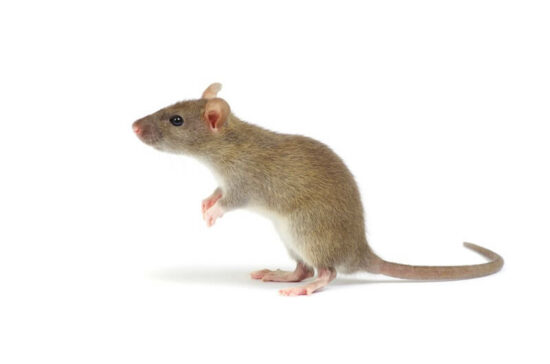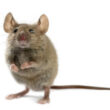Using ammonia for mice is a tactic that’s hotly debated in the DIY pest control community. Some people say it’s highly effective, and others say it’s useless.
This guide will cover everything you need to determine if trying this method makes sense for you.
Table of Contents
Does Ammonia Repel Mice?
It’s easy to feel overwhelmed if you’re dealing with a mouse issue in your home. When you go online and do a search, you can find literally dozens of tips and tricks for getting rid of mice. These methods can range from traditional baits and traps to essential oils and mothballs.
One method that you’re sure to come across while searching is the use of ammonia for mice. Considering the strong, repellent smell of ammonia, it would seem to make sense that one could use it to get rid of mice.
But does it really work?
As with so many pieces of advice that you receive from the internet or from well-meaning friends and family, ammonia’s reputation as an effective mouse repellent varies.
How well ammonia works as a mouse repellent depends a lot on the individual situation. The scope of the infestation, the size of the home and the location of the main infestation are all factors that can determine whether or not ammonia will work as a repellent. In general though, the common consensus is that ammonia does not usually work well, and there are other, more effective, methods to try.
Why do so many people consider ammonia to be a good way to get rid of mice? The main reason is probably due to ammonia’s very pungent smell. If you’ve ever gotten an unwanted whiff while you were using ammonia around the house, you know how it can practically take your breath away. Mice hate the scent of ammonia as much as people do, and the idea is that ammonia will repel them from any areas of the home that contain the scent of ammonia.
The other theory behind using ammonia to repel mice is that it mimics the scent of urine. Urine contains ammonia, and it’s thought that if a mouse smells ammonia around, then it will mistake it for a predator’s urine. The problem with this idea is that a mouse’s urine contains ammonia as well, so they may not be tricked into leaving. Even if ammonia works in this way for a while, once the mice wise up to the trick, they’ll just be back.
So, is using ammonia for mice going to be a magic method? Most likely not. It may help to repel mice for a short period of time, but it’s most likely going to end up being a waste of time and effort. There are better ways to repel mice (either DIY methods or with a pest control specialist).
Does Ammonia Kill Mice?
Ammonia is a poisonous substance, and it will kill mice (and any other animal that ingests it). Not only that, even breathing in the strong, toxic fumes of ammonia may cause death or severe damage. If mice are exposed to the fumes, or if they get into it and swallow some, then they will probably die.
So, does ammonia kill mice? Yes it does, but this is far from a foolproof method.
There are a few issues to consider when trying to use ammonia to kill mice. First and foremost, ammonia and its fumes are extremely toxic, and that means that pets and members of your family are at risk if you use it to kill mice. Since there are other, more efficient methods out there, it may not be worth it to attempt to solve your mouse problem with ammonia.
Another downside to using ammonia to kill mice is that they don’t like the smell of it. That means they probably aren’t going to get close enough to ingest it or breathe the fumes. There are some ways that you could try to use ammonia to kill mice, but they are not guaranteed to work. We’ll take a look at some of them later, but these methods are not going to be something that you’ll want to rely on.
Short of chasing after mice with a spray bottle full of ammonia, you’re probably not going to kill too many mice with it.
How To Use Ammonia To Keep Mice Away
If you’ve done your research and are still set on trying to use ammonia to repel mice or kill them, there are a few things that can be done to increase your chances of success. However, be aware that these methods may not work all the time and in every situation. The best thing is to use them along with a treatment plan set up by your pest control specialist (or add a more robust DIY method to the equation).
Before trying these and other methods, it’s important to understand all safety precautions involved with using ammonia for any reason. Ammonia fumes may do serious damage to the respiratory tract and may even cause death. Of course, never let your kids, pets or any family member near liquid ammonia, spray or any other form.
Let’s take a look at some of the most common ways that people use ammonia for mouse control.
1. Make Ammonia Spray
One pretty simple way to use ammonia to keep mice away is to make a spray with it. All you need is a spray bottle, some ammonia, dish soap and some water. Mix a cup of water, two cups of ammonia and a tablespoon of dishwashing soap. Add this to your spray bottle, and you’re ready to go.
Since the ammonia is diluted in this spray, it’s a nice option for anyone who doesn’t want to deal with the fumes of pure ammonia. However, this spray is still going to be strong, so make sure that you wear gloves, a mask and eye protection. Ammonia has the potential to damage your eyes, skin and lungs, and it’s important to keep this spray well away from kids and pets.
Once you’ve made your solution and have poured it into the spray bottle of your choice, it will be time to get spraying. Ideally, you are going to spray the ammonia solution in places where there is known mouse activity. You can also spray it wherever you think the mice may be hiding.
We’d like to remind you that this ammonia solution is not meant to be sprayed around randomly. Only spray it in ventilated areas where people and pets will not be exposed to the harmful fumes. Ammonia spray should not be placed near heat or near any kind of open flame. It’s quite flammable, so be very mindful of where you spray.
In our opinion, using ammonia spray may not be the best option. It comes with safety considerations, and it’s not guaranteed to work.
2. Soak Rags And Cloths
There’s nothing fancy about this method, but it’s one that lots of people use. Instead of using a spray that is often hard to direct into every nook and cranny, you can soak old rags or pieces of cloth in the ammonia solution that we mentioned earlier. You can use cotton balls as well, or you can try a combination of rags and cotton balls. It’s totally up to you.
Some people use pure ammonia, but we suggest using the homemade ammonia solution for repelling mice. If you want to use the solution, which we suggest, just soak the rags or cloths in it for a few hours. Wring them out, and then you can place them in areas where you’ve noticed mice. Entry points and under baseboards are good spots to try (similar to locations where you would put steel wool). Soaked items will lose their effectiveness quickly due to evaporation, so be ready to replace them often.
Again, it’s important to place your rags, cloths or cotton balls in ventilated areas away from pets and people. Also, don’t place them near heat or open flames.
3. Mix It As A Poison
The do-it-yourself ammonia methods for mice are best geared for those who want to repel these critters or keep them away. If you’re looking for a more permanent solution, then you may want to try making your own ammonia-laced poison to kill the mice in your home.
Before you actually make the poison and put it around your house, you should take a few things into consideration. First of all, this is a poison and not a repellant. Unless you are absolutely certain that you want to kill the mice, it’s better not to use this method.
Secondly, this mixture that you’re creating is dangerous. Not only will it kill any mice that eat it, but it will kill your pets, and maybe even your kids if they get into it. You’ll need to wear gloves, a mask and eye protection when making this poison, and you’ll need to stay protected as you are placing the poison around.
As it happens, making this poisonous mixture is quite easy, and it only requires ingredients that you probably already have on hand. In addition to the protective gear discussed previously, you’ll need ammonia, sugar, borax and flour.
Mix about two-thirds of a cup of ammonia with the flour, sugar and borax. The mixture should not be too runny or too dry, so you can use your judgment as to the exact amounts. Put this mixture into small bowls or plastic containers and place them wherever you think there is mouse activity.
Be very careful where you place this poison. Mice will be attracted to the sweet mixture, but pets and kids may be as well. Make sure to keep it well out of reach.
A Few Other Things To Try
In addition to the common do-it-yourself methods for keeping mice away with ammonia, there are a few other options you can try. Again, they are not guaranteed to work as a permanent solution, but they may provide some temporary relief while you get other options in place. It’s important to note here that it’s normal household ammonia that we are talking about. Anything stronger than that will contain highly toxic levels of ammonia.
Instead of using ammonia in a diluted form to repel mice, some homeowners opt to use ammonia in its pure form. This is not a method that we recommend because the fumes of pure ammonia can be quite toxic, so it’s not that safe to use around your family or pets. However, if you do want to try this method, you’re going to want to place open containers of ammonia in strategic spots around your home. Bottle caps, small bowls or even cotton balls soaked in ammonia will work.
There are various brands of ammonia-based products that you can pick up at just about any home improvement or retail store. These products come in different forms, so choose the one that best suits your particular needs and situation.
Some stores offer scent packs that you can place around, and these are supposedly safe to use around pets and kids. However, we suggest using them with caution. You’ll also find a variety of sprays and foams that contain ammonia, so read the labels and pick the one that seems to fit your needs.
We’ve saved the most effective solution for last, and that involves calling a pest control company. We know that we have mentioned this already, but it really is the solution that is most apt to solve your mouse issue if you have a serious infestation.
You can mess around and try using ammonia to repel mice and keep them away, but these are really only a band aid. Mice may be tiny, but they are very intelligent and adaptive, and they will cotton on to all of your efforts in no time. The only thing that has the potential to permanently take care of your mouse problem is to have experts evaluate your problem and then suggest a treatment plan.
Conclusion
Using ammonia for mice is technically an option that can work, but you shouldn’t expect a whole lot when it comes to effectiveness.
If you’ve had success repelling mice with ammonia or killing them, let us know. We’d love to hear what technique is working for you!


